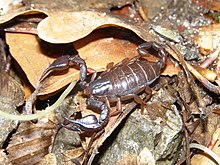| Euscorpius carpathicus | |
|---|---|

| |
| Scientific classification | |
| Domain: | Eukaryota |
| Kingdom: | Animalia |
| Phylum: | Arthropoda |
| Subphylum: | Chelicerata |
| Class: | Arachnida |
| Order: | Scorpiones |
| Family: | Euscorpiidae |
| Genus: | Euscorpius |
| Species: | E. carpathicus |
| Binomial name | |
| Euscorpius carpathicus (Linnaeus, 1767) | |
| Synonyms | |
| |
Euscorpius carpathicus is a species of scorpion endemic to the Romanian Carpathians. It is the type species of the genus Euscorpius.
Taxonomy
Numerous species were previously identified as part of the Escorpius carpathicus species complex and were later clarified to a number of distinct species, including Euscorpius tergestinus and Euscorpius sicanus. However mitochondrial DNA-based phylogenetics identified these as separate species in 2003. Since then, Euscorpius carpathicus has been identified as an endemic species of Romania with a substantially more limited range.
Distribution
The range of Euscorpius carpathicus is limited to the Carpathians and further fragmented into three isolated areas: the western portion of the Southern Carpathians (also known as the Banat Mountains), the Olt River gorge inside Cozia National Park, and the Buzău Mountains. It is likely that the fragmentation of these areas is due to deforestation. The upper altitude of its range is believed to be 450 meters.
The clay substratum in riparian areas of the Carpathians is believed to be important for Euscorpius carpathicus to survive the winters as it burrows into cracks and holes, as is common in other Euscorpius species. Euscorpius carpathicus is also found overwintering in areas with bush cover that create warmer microclimates in river valleys.
References
- "Euscorpius carpathicus". Global Biodiversity Information Facility. Retrieved 2022-05-12.
- ^ Fet, Victor & Soleglad, Michael (2013-03-27). "Morphology analysis supports presence of more than one species in the Euscorpius carpathicus complex (Scorpiones: Euscorpiidae)". Euscorpius. 2002 (3): 1–51. doi:10.18590/euscorpius.2002.vol2002.iss3.1.
- Kovařík, František & Šťáhlavský, František (2020-07-22). "Five new species of Euscorpius Thorell, 1876 (Scorpiones: Euscorpiidae) from Albania, Greece, North Macedonia, and Serbia". Euscorpius. 2020 (315): 1–37.
- Salomone, Nicola; Vignoli, Valerio; Frati, Francesco & Bernini, Fabio (2007-05-01). "Species boundaries and phylogeography of the Euscorpius carpathicus complex (Scorpiones: Euscorpiidae) in Italy". Molecular Phylogenetics and Evolution. 43 (2): 502–514. doi:10.1016/j.ympev.2006.08.023. PMID 17150377.
- Covaciu-Marcov, Severus-Daniel & Ferenţi, Sára (2019). "An endemic species in a protected area: Euscorpius carpathicus (L., 1767) in the Cozia National Park, Romania (Scorpiones: Euscorpiidae)". Euscorpius. 2019 (279): 1–6. doi:10.18590/euscorpius.2019.vol2019.iss279.1. S2CID 134714582.
- Gherghel, Iulian; Sotek, Alexandru; Papeş, Monica; Strugariu, Alexandru & Fusu, Lucian (April 2016). "Ecology and biogeography of the endemic scorpion Euscorpius carpathicus (Scorpiones: Euscorpiidae): a multiscale analysis". The Journal of Arachnology. 44 (1): 88–91. doi:10.1636/P14-22.1. S2CID 87325752.
| Taxon identifiers | |
|---|---|
| Euscorpius carpathicus | |